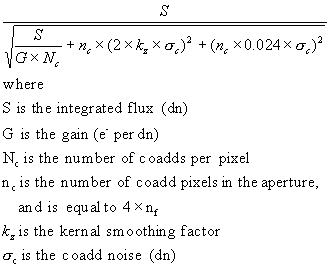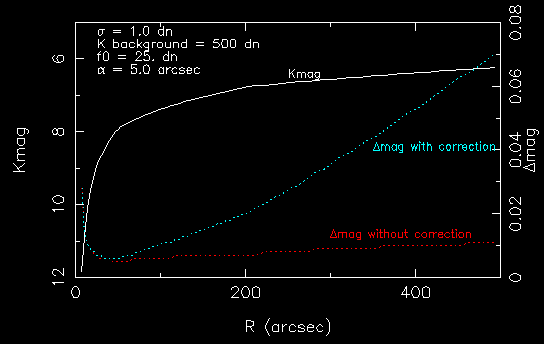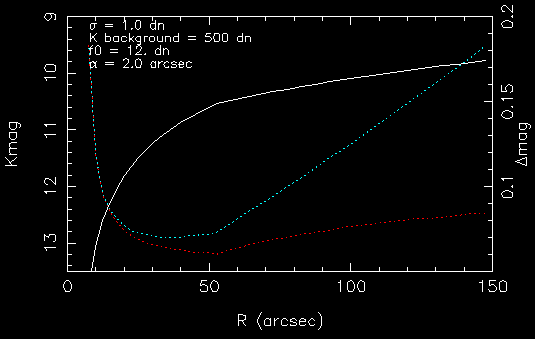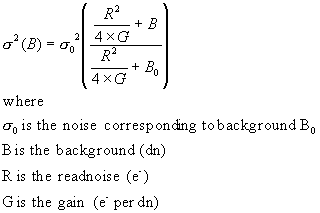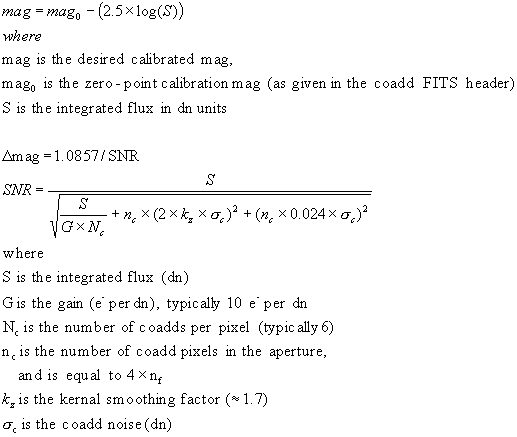The calculation of the SNR is straightforward working from the individual frames that are averaged together to produce the coadd. If one considers only the individual frames, which are independent, and ignores the uncertainty due to the background fit (which will be considered below), the SNR is:
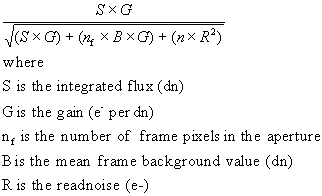
Here "dn" refers to "data number", whose conversion to a more physically meaningful unit is through the "gain" (e.g. electrons per dn).
In general, 5-6 frame pixels are averaged to produce one coadd pixel; hence the formula above counts each of those frames separately.
In practice the gain and read-noise parameters are a function of the 2MASS hardware period and are not easily incorporated into the photometric uncertainties (see prescription in the Additional Sources of Uncertainty section below). The most robust method toward estimating photometric uncertainties is to use the measured RMS in the frame or coadd background (after large-scale background removal). The noise term is

ii. Coadd Noise
As mentioned above, the pixels in the coadd are correlated since the
sampling of the coadd is two times finer than the frame sampling and because
of the smoothing function used to produce the coadd flux estimates. The
coadd noise is a function of the background Poisson noise, the read-noise
and high-frequency structure (e.g., atmospheric airglow). The coadd
noise,
sigmac, must be corrected for the resampling and smoothing arising
used in the co-addition process. The typical number (Nc)
of frames that are coadded is six. The resampling is carried out with a
dither-optimized kernel, resulting in a
slight smoothing of the data. The coadd RMS noise can be written as
We can now re-write the coadd signal-to-noise using the
measured coadd noise
Parameter Values
Example Consider a 13th mag galaxy, whose size is 15´´ in circular
diameter. Let the measured RMS of the background-removed Ks-band
coadd be 1.1 dn.
The resultant S/N is 11.9 and the magnitude uncertainty (delta_mag) is
0.091 mag. The integrated flux, S, was calculated using the first equation
in Handy Equations, with K0=19.93 mag.
iii. Uncertainty Due to the Background Fit
For extended source characterization, the coadd background is
removed using a cubic-polynomial surface. Details of the background removal
are given in the IV.5.a.i
The noise introduced by the background determination depends on the
structure of the background. For example, if there is no variation in
background across the entire coadd, then all cubic polynomial coefficients
will be zero except for the mean level, which will be determined from the
mean of all the 8´ x 8´ median sections. The error in the determination of
that mean is ~0.6% of the coadd noise (see
Analysis of Photometric Noises for 2MASS Galaxies
for additional details).
If the background variation requires a cubic, and is well-fit
by a cubic, which is normally the case except for H-band observations with
high airglow, then intuitively the coadd is effectively divided into 4x4
regions with the resulting errors then being 4 times higher. The resulting
noise in the determination of the background is then ~2.4%
of the coadd noise. If the background variation requires a higher-power
polynomial than a cubic, then the error in the background will no longer be
determined by the pixel noise. Instead, the background error will result
from the residual error after a cubic polynomial is fit. This will be the
case for airglow variation, which can vary on high spatial frequency scales.
See Photometric Error Tree for more
details.
We assume a net 2.4% of the coadd noise per pixel uncertainty in the
background fit. The noise term is thus
Note that this term is negligibly small for most 2MASS galaxies,
whose diameters are typically less than 20´´.
For large galaxies, however, this term can dominate the S/N. Adding
this term to the coadd signal-to-noise equation, we have
For very large galaxies this uncertainty due to the background fit
dominates the total flux uncertainty. This is demonstrated by the
surface brightness and noise profiles shown in
Figures 1 and 2. Figure 1
shows a very bright galaxy (similar to NGC891) with an exponential
surface brightness profile. Figure 2 shows a bright galaxy more typical to
the 2MASS survey. The radial profile follows
f0exp(-r/alpha). The total noise (delta_mag)
is shown with and without the background fit noise correction. Note that the
radial size limit for cataloged 2MASS galaxies is ~120´´, while for the
2MASS Large
Galaxy Atlas there is no size limit.
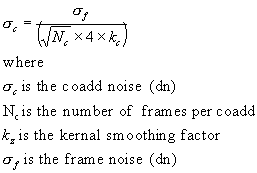
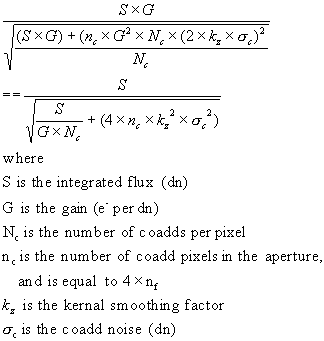
![]()
